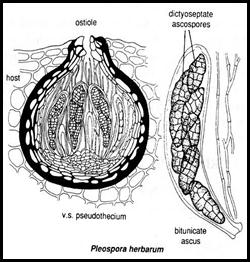

النبات

مواضيع عامة في علم النبات

الجذور - السيقان - الأوراق

النباتات الوعائية واللاوعائية

البذور (مغطاة البذور - عاريات البذور)

الطحالب

النباتات الطبية


الحيوان

مواضيع عامة في علم الحيوان

علم التشريح

التنوع الإحيائي

البايلوجيا الخلوية


الأحياء المجهرية

البكتيريا

الفطريات

الطفيليات

الفايروسات


علم الأمراض

الاورام

الامراض الوراثية

الامراض المناعية

الامراض المدارية

اضطرابات الدورة الدموية

مواضيع عامة في علم الامراض

الحشرات


التقانة الإحيائية

مواضيع عامة في التقانة الإحيائية


التقنية الحيوية المكروبية

التقنية الحيوية والميكروبات

الفعاليات الحيوية

وراثة الاحياء المجهرية

تصنيف الاحياء المجهرية

الاحياء المجهرية في الطبيعة

أيض الاجهاد

التقنية الحيوية والبيئة

التقنية الحيوية والطب

التقنية الحيوية والزراعة

التقنية الحيوية والصناعة

التقنية الحيوية والطاقة

البحار والطحالب الصغيرة

عزل البروتين

هندسة الجينات


التقنية الحياتية النانوية

مفاهيم التقنية الحيوية النانوية

التراكيب النانوية والمجاهر المستخدمة في رؤيتها

تصنيع وتخليق المواد النانوية

تطبيقات التقنية النانوية والحيوية النانوية

الرقائق والمتحسسات الحيوية

المصفوفات المجهرية وحاسوب الدنا

اللقاحات

البيئة والتلوث


علم الأجنة

اعضاء التكاثر وتشكل الاعراس

الاخصاب

التشطر

العصيبة وتشكل الجسيدات

تشكل اللواحق الجنينية

تكون المعيدة وظهور الطبقات الجنينية

مقدمة لعلم الاجنة


الأحياء الجزيئي

مواضيع عامة في الاحياء الجزيئي


علم وظائف الأعضاء


الغدد

مواضيع عامة في الغدد

الغدد الصم و هرموناتها

الجسم تحت السريري

الغدة النخامية

الغدة الكظرية

الغدة التناسلية

الغدة الدرقية والجار الدرقية

الغدة البنكرياسية

الغدة الصنوبرية

مواضيع عامة في علم وظائف الاعضاء

الخلية الحيوانية

الجهاز العصبي

أعضاء الحس

الجهاز العضلي

السوائل الجسمية

الجهاز الدوري والليمف

الجهاز التنفسي

الجهاز الهضمي

الجهاز البولي


المضادات الميكروبية

مواضيع عامة في المضادات الميكروبية

مضادات البكتيريا

مضادات الفطريات

مضادات الطفيليات

مضادات الفايروسات

علم الخلية

الوراثة

الأحياء العامة

المناعة

التحليلات المرضية

الكيمياء الحيوية

مواضيع متنوعة أخرى

الانزيمات
Class: Loculoascomycetes
المؤلف:
Kayser, F. H
المصدر:
Medical Microbiology
الجزء والصفحة:
17-11-2015
4036
Class: Loculoascomycetes
Fungi in this class are distinguished by having bitunicate asci. These have two distinct, separable walls. The outer wall is thin and inextensible and the inner thick and extensible. At maturity, the outer wall ruptures at the apex allowing the inner wall to expand under hydrostatic pressure. The ascospores,

which are usually coloured and multicellular, are released one at a time through an apical pore in the inner wall. The ascocarp is usually a pseudothecium which closely resembles a perithecium in form and function but develops quite differently.In pseudothecial formation, vegetative hyphae aggregate into a spherical structure with heavily melanized outer layer. Asci develop in a single cavity or loculus which form within this.
The pore or ostiole, through which the asci are discharged, arise by breakdown of pre-existing hyphae at a predetermined site.
Order: Dothideales
Family: Venturiaceae
Venturia inaequalis
causes apple scab, an economically important disease affecting apple leaves and fruit. The fungus over winters mainly as developing pseudothecia on fallen apple leaves. The cold of winter triggers ascus development and as the new apple leaves unfold in the spring, asci mature and discharge their ascospores up into the turbulent air after a good shower of rain. They impact on leaves and germinate. Bundles or strands of hyphae develop in a plate- like manner under the cuticle. At a later stage the cuticle is ruptured by the growth of short, brown conidiophores, giving the scab a velvety, brown to black appearance. The conidia are dispersed by rain splash and wind from spring to early autumn spreading the disease. At leaf fall in the autumn the fungus grows out from the leasions and forms pseudothecial initials.
Live material:
To identify various locally collected specimens of mildew to genus and species. A variety of plant species infected with mildew will be available. Microscopic mounts will be prepared using a dissecting microscope to select mature fruiting bodies (cleistothecia) and
lifting one or a few cleistothecia off of the leaf into a drop of water or glycerine. Gently add a cover slip, and observe the characteristics of the cleistothecia before applying gentle pressure to the cover slip, and observe the characteristics of the cleistothecia before applying gentle pressure to the coverslip to force release of the asci. Using the attached keys, you are required to identify at least three of these specimens to species and then to have your identifications confirmed by one of the instructors.
 الاكثر قراءة في الفطريات
الاكثر قراءة في الفطريات
 اخر الاخبار
اخر الاخبار
اخبار العتبة العباسية المقدسة

الآخبار الصحية















 قسم الشؤون الفكرية يصدر كتاباً يوثق تاريخ السدانة في العتبة العباسية المقدسة
قسم الشؤون الفكرية يصدر كتاباً يوثق تاريخ السدانة في العتبة العباسية المقدسة "المهمة".. إصدار قصصي يوثّق القصص الفائزة في مسابقة فتوى الدفاع المقدسة للقصة القصيرة
"المهمة".. إصدار قصصي يوثّق القصص الفائزة في مسابقة فتوى الدفاع المقدسة للقصة القصيرة (نوافذ).. إصدار أدبي يوثق القصص الفائزة في مسابقة الإمام العسكري (عليه السلام)
(نوافذ).. إصدار أدبي يوثق القصص الفائزة في مسابقة الإمام العسكري (عليه السلام)


















